Russia/St. Petersburg to Moscow River Boat Cruise
by Debora Johnson
Picture Galleries
Domes of Russia
Faces of Russia
Fountains of Russia
Russia and Horses
St. Petersburg to Moscow/Out and About
Vodka Museum/Mondraga
More Articles on Russia
Russian Folk Dancing
Balalaika also Balabaika
Russian Alphabet to English Pronunciation
Russian Horse Breeds:
All About Our Trip - Cruise of the Czars
St. Petersburg to Moscow by Riverboat
Much of the following information was taken from the Smartours website as well as handouts given to us by our guide on the Russia River Boat Cruise Trip.
Day 1: Depart New York this evening on overnight flight to St. Petersburg on Finn Air.
Day 2: Arrive St. Petersburg. Today arrive St. Petersburg, one of Europe's most magnificent cities, often called "Venice of the North." Board riverboat MS Konstantin Korotkov
 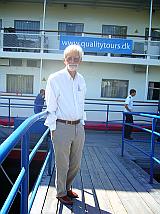
All aboard! Riverboat MS Konstantin Korotkov and my Bill. 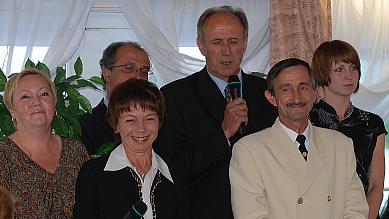
Captain right front, Our guide, Galia, left front, other crew members in back 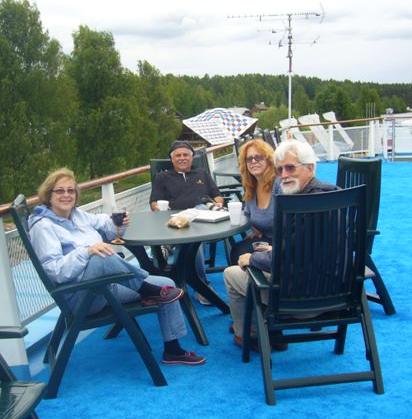
The four of us: Bill, Brenda, Don and Deb - Counter-clockwise 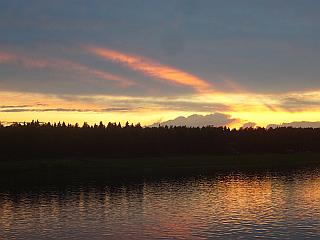 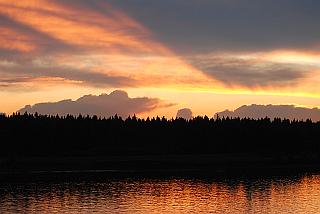
The White Night--Dusk and Dawn! 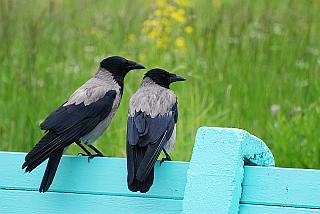
This type of bird followed the riverboat all the way to Moscow. They were also plentiful on land. When they made sounds it was much the same as our crow. Day 3: Docked in St. Petersburg for the next two days. Enjoyed the architecture, natural beauty and rich culture of the city. St. Petersburg, the former capital of Czarist Russia, was founded by Peter the Great in 1703. Took a morning guided tour of the priceless art collection presented at the famous Hermitage Museum, located at the Winter Palace.

Ponies walking along in St. Petersburg Day 4: Departed St. Petersburg on an optional tour which took us to outside the city to Peterhof Palace, the summer residence of the Czar. It was built to rival Versailles and is surrounded by magnificent gardens. We also visited the impressive Catherine Palace, the former residence of Russian royalty containing numerous art masterpieces.
The amber room at Catherine's Palace, St. Petersburg: Amber Room
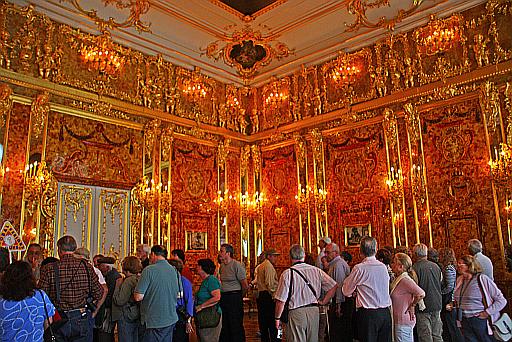
©BDavidson Russia's "White Nights" (Northern Lights)
Beginning in late May and continuing through July it is quite unique in St. Petersburg. Although, more precisely June 11-July 2, the White Nights (Belilye Nochi) reign in St. Petersburg. Because of St. Petersburg's geographical location, 59 degrees 57' North, (about the same latitude as Olso, Norway, the southern tip of Greenland and Seward, Alaska), and due to such a high latitude, the sun does not go under the horizon deep enough for the sky to get dark. We had daylight--the dusk meeting the dawn with no dark night in between. It was bizarre to sleep on the ship because the light filtered through our cabin window around the clock. The city is perpetually alive during this time--only the street lights remain silent--the people are out! As we cruised toward Moscow there was a difference in light, however, it still remained bright outside far into what would have been night! You can see a few pictures that we took of what could double as dusk and dawn. No dark in between! I will say that it does reek havoc with one's internal clock and add the 8 hours difference and jet lag--it can take a toll on your body.
Mondraga (Mondrogi)
Day 5: Mondraga (Mandrogi) Over the next few days we sailed along the scenic Volga River en-route to Moscow and to get a close-up view of rural and traditional Russia as we made several stops at unspoiled and rarely visited local villages along the river. After a morning of sailing, we arrived at the charming town of Mondraga. I must say it was a surprise as everything looked new--not historic. It was quite touristy, but still lots of fun. The construction of this typical Russian village began about 15 years ago. The revival of the village began in 1996. At that time the place of development was a coastal meadow overgrown with osiers. Today it is the center of tourism and rest. Cruise ships going along the Volga-Baltic waterway stop here. In 1999 the Government of the Russian Federation adopted a resolution on charting of the settlement Verchnie Mandrogi on the map of Russia. The village Verchnie Mandrogi is unique in respect to its geographic historical and natural parameters. Economic prosperity in this region fell during the period before Peter the Great, before opening of the Baltic seaway. People produced iron, quarried granite, constructed ships and traded.
During the war of 1941-1945 the village Verchnie Mandrogi consisted of 29 homesteads which were burned down. The people settled in other villages. Old foundations of former constructions remained. A complex of farmstead-type houses decorated with carving, two hotels, buildings of the post office and the village of handy craftsmen imitating boyar rich houses, a country estate, the Museum of Vodka, a restaurant "Gostinh Dvor" are built in Mandrogi on these original remaining foundations. There is a stable, quail and rabbit farms.
The permanent population is over 150 people. More than 200 people come to work every day. Eleven natives have been born in the village since the time of its foundation. There is a kindergarten and school. In the village of the handicraftsmen the skilled workmen of folk trades create the works of art themselves but also instruct in uneasy (and often forgotten) intricacies to all. There you can learn to weave, embroider, matreshkas, learn pottery and wood engraving. The peculiarity of the program "Verchnie Mandrogi" is the distribution of the earned resources. The are only used for development, salary of the workers and participation in the maintenance of the Gorchakov School in the town of Pavlovsk.
The school was founded in resemblance of Tsarkoe Selo lycee in the town of Pushkin, in which the famous Delvig, Gorchakov, Pushkin studied. Children study free of charge and at the same time they receive a scholarship. Educators are with the children 24 hours a day. The children spend their holidays in different countries where they study that history and people. Apartments are built for the pedagogues.
Ordinary people work in Mondrogi as a collective. They work to realize their ideas. The mandatory condition is observance of two rules: Nobody drinks and nobody steals in the village. The village is unusual in respect to its nature, people, and architecture. There were a range of fascinating wooden houses which operated as hotels and restaurants. A must do is the vodka tasting in the Vodka Museum. It was great fun. In the workshop area where I purchased two lovely hand-made, amber necklaces and got the signature of the craftsman. One of the necklaces is a birthday present for my daughter, Lindsey. The other necklace was for me! There is an open air market where you can try the Russian blinis hot from an open-air Russian stove. These are served with a variety of jams. There is also a range of Russian pastries, pirozhki, with different fillings including berries, potatoes, cabbage, eggs, onions, meat, etc.
We found the stables and were given a private tour by the owners. I asked the gentleman below what kind of draft horses were on the island. The large draft horses are crosses between the Shire and Clydesdale breeds or Vladimir Heavy Draft. That was great fun!
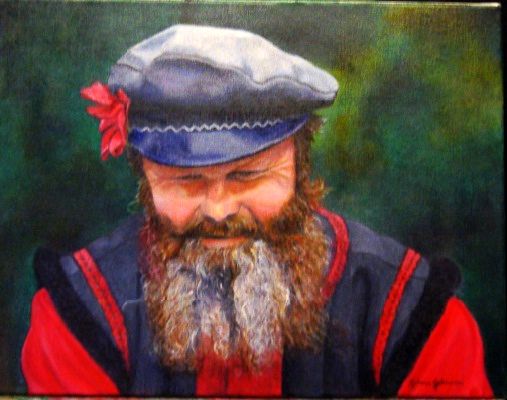
Oil Painting by Debora Johnson
"Man of Mondraga" The Svir River
The Svir River is 215 km long; it connects the two largest lakes in Europe: Ladoga and Onega. Ever since the first settlements appeared along the river over 5,000 years ago, the region has been considered severe and wild. During tzarist times the Svir River was the place of exile. During the communist era it was targeted for hydropower potential. Regardless of the country's political situation, the Svir and its forests have always provided Russia with timber. Even today the main occupation of those living along the Svir is lumbering.
Lake Ladoga
Covering an area of 18,000 sq. km and containing 900 cubic kilometers of water, Lake Ladoga resembles a sea more than a landlocked body of fresh water. It is the largest lake in Europe and is known for its moody temperament. Depths in its northern parts reach as far down as 230 m, while in the south stony and shallow areas can impede navigation. More than 30 rivers supply Ladoga with water, yet only one river, the Neva, flows from it. Baltic salmon and Baltic sturgeon are among the numerous species of fish inhabiting the lake. During the siege of Leningrad in 1941-1944, Ladoga helped the besieged city to survive as food rations and other essential supplies were transported along the road that was laid across the ice of the lake. This road is known as "the Road of Life." Today the lake continues to sustain St. Petersburg by supplying it with its main source of drinking water.
Day 6: Kizhi Island.
Bill and I awoke this morning at the Island of Kizhi, situated in the northern part of Lake Onega. Kizhi boasts a delightful open-air museum highlighting the picturesque architecture of the region. A guided walking tour included the Church of Transfiguration, a truly outstanding masterpiece of wooden structure. Know that there are lots of mosquitoes on Kizhi Island so make sure to take Deet Insect Spray with you.
The Island of Kizhi is located in the north-eastern region of Lake Onega. The Island of Kizhi is home to an outdoor museum of fascinating edifices of Northern Russia. The architecture is wooden and includes churches, chapels, bell towers, peasant houses, granaries, barns, windmills and bathhouses. The focal point is the remarkable Transfiguration Cathedral built as a summer church in 1714 with 30,000 shingles on 22 separate cupolas situated on 5 tiers. The neighboring Intercession Chapel of the Resurrection of Lzarus was built in 1391 making it the oldest standing wooden church in Russia.
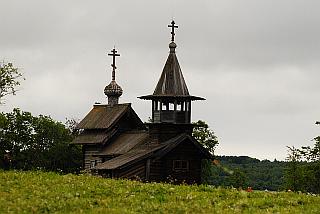 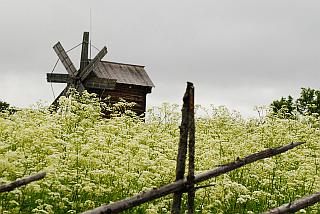
The generally accepted version of its early beginnings is that it was an ancient pagan ritual site for northern tribes, though the island's name supposedly was derived from an old Karelian word for "game." In the 11th century Russian settlers established a natural parish there. In the 18th century, as increasing numbers of craftsmen left Kizhi to work in St. Petersburg, the island entered a period of decline in the 19th century from which it never recovered.
Perhaps the most intriguing facets of the island itself are the colorful myths:
- Dental problems are said to be rectified by rubbing against the small Archangel Michael Chapel, the logs of which actually have been visibly worn by hopefuls.
- Taking a bath on the island is supposed to ensure one of marriage within a year. Whether or not marriage is considered one of the keys to personal happiness is also not clear. In order for the bath to work it must be drawn from a mixture of herbs and kvas (a beverage made from fermented dark bread), and it must be placed under a spell by a witch.
- Business success is virtually guaranteed upon sighting mermaids combing their locks on the footbridge near the small wooden bathhouse.
Lake Onega
Lake Onega spans a 10,000 square kilometer area, making it the second largest lake in Europe, bowing in size only to its twice-larger neighbor Lake Ladoga. Depths of Lake Onega average 30 meters, but include cavities reaching as far down as 120 meters. MOre than 50 rivers and 1,000 streams feed Onega, but only the Svir River which connects it to Onega, originates from Onega. The lake contains over 1,300 islands, most of which lie in the north where forests of pine stand at the edges of rocky, jagged coastline. Linden and elm trees are more common in the middle and south areas, where sandy shores slope into shallow bays of reeds.
Day 7: Goritzi (turn your speakers off there is music on this site)
Today, we stopped at the quaint riverside town of Goritzi, typical of the charming villages along the river. We did our own exploration along with Brenda and Don. A caviar and blini party was provided and really delightful.
Goritsy is a typical Russian village located on the Sheksna River. Its name is derived from the Russian word "gora," which means a hill. The population of the village is several hundred people living in about 300 houses. There is an elementary and junior high school, three shops, a post office, doctor's office and a library. The village of Goritsy is home to the Resurrection Convent. The convent was founded in 1544 by Moscow Princess Yefrosiniya, wife of Ivan the Great's youngest son. Yefrosiniya was among a group of boyars who opposed the reigning tzar, Ivan the Terrible. This group was plotting to assassinate the tzar and install Yefrosiniya's son on the throne. In 1563 Ivan the Terrible uncovered the plot and Yefrosiniya was exiled to the very convent she founded in Goritsy. She was forced to take the veil under the name of Yevdokiya, while her son was executed in Moscow.
Yefrosiniya quickly tired of the monastic life and began appealing regularly to Ivan the Terrible for her pardon and release. The tzar, fed up with the constant pleas, one day sent word to the convent that Yefrosiniya was to be freed. He sent a ship to Goritsy which collected the princess, promptly took her to the middle of the Sheksna River, and ordered that she be drowned. Princess Yefrosiniya was the first in a long line of women who were compelled to inhabit the convent. Ivan the Terrible exited his fourth wife there, as well. The convent regularly hosted 50 to 500 exited women in addition to its regular sisterhood.
Structures in the complex exclude three churches: the Resurrection Cathedral (built in the 16th century), St. Dmitry Chapel and belfry (early 17th century) and Trinity Cathedral (early 19th century). The convent was closed in 1932 and reopened in 1997, when eight nuns moved there and active restoration began on its grounds.
White Lake
The shores of White Lake were settled by Veps tribes in the 8th century. Ever since it has served as a trade bridge between Russia's North and South. The lake was incorporated into the Marimskaya System in the 19th century and subsequently into the Volga-Baltic Canal. A host of rivers flow into the White Lake, contributing to its 1,400 square km (541 square mile) area. Only one river, the Sheksna, drains the lake. The depth of the lake is 5 m (16.4 feet).
Sheksna River (186km = 111 miles)
The Sheksna River connects the White Lake to the Rybinsk Reservoir. The name Sheksna is thought to be derived from a Finnish term meaning "a sledge-covered tributary" (sledge is a grass-like plant found in swamps and on riverbanks). Since the time of Kievan Rus the river has played a vital role in connecting the northern lands to the Volga.
Blini with Caviar and Crème Fraîche/Recipe courtesy of Williams-Sonoma Food Channel
Blini, Caviar, Crème Fraîche, active dry yeast, eggs, butter, whole wheat flour, Vegetable Oil, Hors d'Oeuvres, appetizer, holiday, christmas. Although blini are best served soon after they are prepared, they can be made up to a week in advance. Let them cool to room temperature, then freeze in an airtight container, placing paper towels between the layers of blini so they will not become soggy. When ready to serve, place the frozen blini on a baking sheet and heat in a 200ºF oven until just warmed through, 15 to 20 minutes.
Ingredients:
1/4 cup whole wheat flour
1/2 cup buckwheat flour (use more whole wheat flour if buckwheat is unavailable)
2 cups sifted all-purpose flour
1 1/4 teaspoons active dry yeast
1 teaspoon sugar
1 cup warm water
1 cup milk
3 eggs, separated
1/2 teaspoon salt
2 tablespoons unsalted butter, melted
Vegetable oil for frying
4 to 6 ounces caviar
1 pint créme fraîche
Preparation:
In a small bowl, make a sponge by combining the whole wheat flour, buckwheat flour, 1 cup of the all-purpose flour, the yeast, sugar and warm water; stir until blended.
Cover tightly with plastic wrap and let stand in a warm place until doubled in volume, 1 to 1 1/2 hours.
In a small saucepan over medium heat, scald the milk by cooking it to just under a boil. Let cool to room temperature and set aside.
In a large bowl, whisk together the egg yolks and salt until light in texture and color, then gradually whisk in the butter until smooth.
Stir in the scalded milk, then stir in the remaining 1 cup all-purpose flour until smooth. Fold in the sponge until the batter is smooth.
Cover tightly with plastic wrap and let stand in a warm place to rise, 30 to 40 minutes.
In a large copper or other mixing bowl, using a whisk, beat the egg whites until stiff peaks form. (When the whisk is lifted out of the bowl and inverted, the whites on the end of the whisk should remain upright, with just a slight bend at the tip.)
Using a spatula, gently fold the egg whites into the batter and let stand for 10 to 12 minutes.
In a large non stick fry pan or griddle over medium heat, warm just enough oil to coat the bottom of the pan.
Using a tablespoon, drop the batter onto the pan (1 tablespoon batter will make a blini 3 inches in diameter). Cook 3 to 5 blini at a time; do not crowd the pan. Cook until golden, 2 to 3 minutes per side.
Fill a large serving bowl with chipped ice, and set the tin of caviar and a dish of créme fraîche on top. Serve the blini alongside. You can fill the blini with whatever you desire!
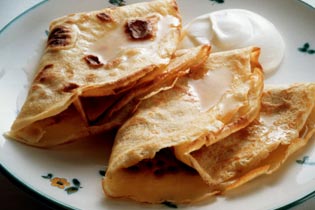
Today's port of call is Yaroslavl, founded in the 11th century. Its main attractions are in the area around the main square anchored by the impressive Governor's Palace. A guided tour included the ancient monastery and the Church of Elijah, renowned for its precious frescoes.
Yaroslavl is among the oldest and most well known of all Russian provincial cities situated on the Volga River. Founded by Prince Yaroslav in 1010, the city is older than Moscow. Yaroslavl is famous for its magnificent churches and medieval wall paintings. The Church of St. Elijah the Prophet, built in 1650, features unique asymmetrical exterior and splendid frescoes. The Savior-Transfiguration Monastery, founded in the 12th century, is one of the most beautiful in Russia. Today Yaroslavl is an important commercial center, being connected to Moscow by all major transportation routes. Most of the population of 650,000 people works in various local industries, including oil refining and manufacturing of rubber tires.
Rybinsk Reservoir or Rybinsk Sea
Before the formation of the Rybinsk Reservoir, there was a problem that in summer the peak navigational period, water tended to run low. The locks of the Mariinskaya System were ill-equipped to solve the problem. Ships were often pulled from one lock to another with ropes. It took up to three months to travel between Sybinsk and St. Petersburg. In 1932 Joseph Stalin came up with the "Big Volga" plan, i.e., to dam the Volga and Sheksna in order to create a massive reservoir. Thus, 700 villages and 4,000 hectares of fertile plow land were flooded. The construction was carried out by the forced labor of GULAG prisoners. The flooding of the reservoir began in 1941 and was kept under wraps because of the mass destruction, human displacement and ecological damage it necessitated.
Because of its size (its area is 4,500 square km), the Rybinsk Reservoir is commonly called the Rybinsk Sea. In reality it is a massive flood basin covering the natural beds of many rivers, including the Volga and Sheksna. At the approach to the Rybinsk Hydroplant, the statue of Mother Volga extends a welcoming hand. Rybinsk Hydroplant is located on two rivers, none of which are here anymore. The dam and hydro station lie in the old mouth of the Sheksna River, and the lock in the former bed of the Volga. Exiting the lock, ships navigate the waters of the Volga River.
Volga River
From its remote source in the Valdai hills northwest of Moscow, the Volga River meanders up to the Rybinsk Reservoir, changes direction, commences winding southeast to Kazan before twisting westward to Volgograd, where it plunges finally southward to the Caspian Sea. Its 3,688 km length makes it the longest river in Europe. The Volga River is the central artery of Russia's vast river network. Via a network of man-made canals it is connected to all 5 of the country's major seas. Half of all river freight in Russia is transported on its waters, which are also used to irrigate the steppes of the South. The river usually is navigable from March to mid December.
Rybinsk
Rybinsk is a large city located on the banks of the Volga River and the Rybinsk Reservoir with the population of around 300,000 people. The name "Rybinsk" derives from the word "ryba" which means fish, and it means Fish Town. In the 20th century the city was renamed three times. It used to be called "Scherbakov" and "Andropov" after the Communist Party leaders. An unmistakable sight in Rybinsk is the neo-classical five-domed Savior Transfiguration Cathedral with the baroque belfry.
Day 9: Uglich
We docked in Uglich, Russia's second oldest city and one of its most beloved. We visited the imposing Cathedral and saw the fine collection of Russian Orthodox Architecture.
The town of Uglich was first mentioned in the Chronicles in 1148. The town's name is explained by three separate theories. The first is that it is derived from the Russian word "ugol" meaning "angle" for the Volga makes a sharp bent at Uglich; the second is that it is again derived from the Russian word "ugol" which means "coal" for the coal was burned here; the third is that it is derived from the name of the town's original settlers, a Finno-Ugric tribe, a supposedly called "uglichi."
Moscow
Moscow Canal
Not until 1825 was the city of Moscow linked to the Volga via a canal to the Moscow River. The first canal was built primarily to transport raw materials needed to build Moscow's Church of Christ the Saviour. The canal had a limited lifetime, eventually suffering neglect at the hands of railroads.
Historically plagued by short water supply, Moscow by the 1930s needed to be lined to a major water source. The Volga River was targeted to solve Moscow's dilemma. Two routes for a canal from Moscow to the Volga were initially proposed. Both proposals ultimately were rejected in favor of the present day canal which bullies its way straight to the Volga in true Stalinist fashion. The endeavor was carried out with great hassle and with absolute disregard for the lives of the GULAG prisoners who were forced to dig it out shovelful by shovelful. The entire project required building 240 "complicated constructions," including 7 concrete dams, 8 earthen dams, 11 locks, 8 hydroelectric plants, 5 pumping stations, 15 bridges and 2 tunnels. On July 15, 1937, inland Moscow woke up as a port connected by water to all 5 of Russia's major seas.
Day 10: Arrived in Moscow which is the historic Russian capital where our riverboat docked for the next two days. We enjoyed a guided afternoon tour of the city's major highlights: Red Square, St. Basil's Cathedral with its colorful onion domes and the Kremlin, the seat of the Russian government and the center of the Russian Orthodox Church.
Day 11: On our guided walking tour of the Kremlin's grounds we saw the Czar's Cannon and Czar's Bell. This is the largest bell in the world, weighing almost 202 tons and standing more than 6 metres high and 6.6 metres across. There is also the architecturally striking Cathedral. Bill, Brenda, Don and I also visited the ornate Metro system and used it, too. Arbat pedestrian street is good fun. We stopped in a small cafe, sat in the outdoor area, enjoyed a Capuchino and light coke while watching the parade of people go by. It is quite a scene!
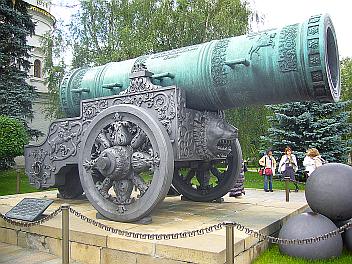 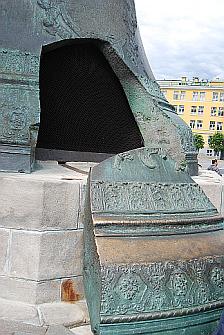
Czar's Cannon and Bell 
Changing of the guard at the Tomb of the Unknown Soldier/Moscow 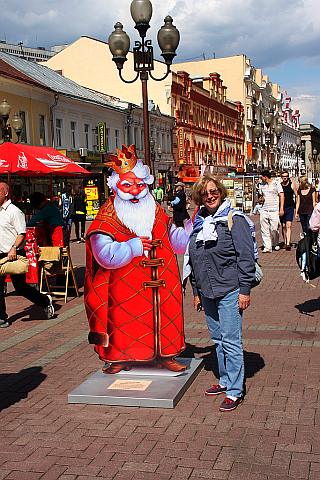
On Arabat Street Day 12: Moscow/New York. After breakfast we transferred to the airport for our return flight to New York. Our 6:30 PM American Eagle flight from New York to Washington, DC was cancelled, as usual, and we had to wait until 10:15 PM before we left New York. I have vowed to never fly American Eagle, again! Bill agrees. We have sent a letter to the airlines requesting a refund of the expensive tickets that we purchased so that we could get home to DC in one day. We will see if American Eagle even responds.
Must Do in Moscow!
Having eaten too many bad meals on the ship, and being unable to chew the pork and chicken, we decided that some really excellent cuisine was in order. Reservations were made for us at the Central Writers Club. Bill and I wanted to celebrate his birthday with a really fine dinner and lovely atmosphere. We invited our friends, Brenda and Don, to join us as our guests for dinner. We met them on a trip to Machu Picchu, Ecuador and the Galapagos Islands, and thoroughly enjoy their company. Everything about the evening was fabulous from the fine wine to every course served to each one of us! There was our main waiter for the table and four more to provide service with flare when the food was brought to the table. It was almost like a dance choreography. Don set his camera down on the floor after we were seated and before you could blink your eyes a stool was brought and set beside his feet and his camera was placed on the stool. We have only experienced this gesture one other time and that was in Metropole Restaurant in Hanoi, Viet Nam. That, too, was an exquisite dining experience! I would also like to add that we took the Metro back to the ship dock. That was a fun experience done late at night. The Russians could not have been lovelier. They were most helpful. Bill, Brenda, Don and I were getting quite good at using pantomime in asking for help. It takes about 40 minutes to go from downtown Moscow to the dock. The cost is less than $2.00 per person. If you were to take a cab it would cost at least $50.00 one way plus a 10% tip, and you must negotiate the price of the cab ride in Russia before you get in the cab! That is quite difficult to do if nobody speaks the same language. Of course, numbers are universal and so is the sign of the dollar! ($) You can always pull out a map, pen and paper--point then write the dollar amount of the cab fare or negotiate. A point to remember.
Central Writer's Club - Housed in an old, stately mansion from the 1890s, the setting itself is worth the visit. The Central House of Writers Restaurant offers exotic treats like Grilled Venison, Mushroom Soup served with fried mushrooms or Pelmeni stuffed with smoked duck under basil sauce. Each one of us had something different in all the courses. I must say that my escargot was the best that I have ever eaten anywhere in the world. My Bill's suckling pig was so tender and juicy that he just needed to look at it and his next bite was ready for his lips. Brenda and Don thoroughly enjoyed their selections, as well. The restaurant is housed and owned by the Central Writers Club, hence the name. This club has been the central meeting place for the elite among Soviet and now Russian writers and poets for more than 70 years. Sitting in the restaurant you might well be rubbing elbows with the most famous of Russian writers who gather there on a regular basis. The entire dining experience was outstanding.
 CAREFUL - Suggestions -Take Note!
- In Russia your passport is taken as you board the ship and kept in a safe. That always makes me a bit nervous having lost a passport in Cambodia! Bill and I went down to retrieve our passport several days before we were to leave the ship. We did not want to take any chances. It turns out that they gave me the wrong passport. Always look at your passport to make sure it is yours. Then we were given a song and dance that they would find it when there was a quiet moment. I asked our guide, Gaelia to please retrieve my passport ASAP--she did, immediately. This also happened to several other people on our trip. Beware!
- While eating dinner, one evening, I went to take a bite of the vegetarian meal that I had ordered, and a nail fell out of my food onto my plate. Make sure to take a look at what you eat before you put it in your mouth.

The nail! - The breakfasts were fine on the trip. Lunches were adequate. Dinner meat selections would pull the caps off your teeth and dislodge your fillings! To say the meat was tough would be an understatement. The fish was billed as white fish, however, not the white fish that we are accustomed to eating. Our white fish is generally mild--not fishy. This white fish was really heavy and fishy flavored. Be warned. Everything was plated and served nicely. I tended to pick through my food carefully before eating it after the nail incident.
- Careful when you are showering. The water temperature will be fine then all of a sudden the hot water will come blasting out and scald you! This immediate change in temperature could really be dangerous.
|